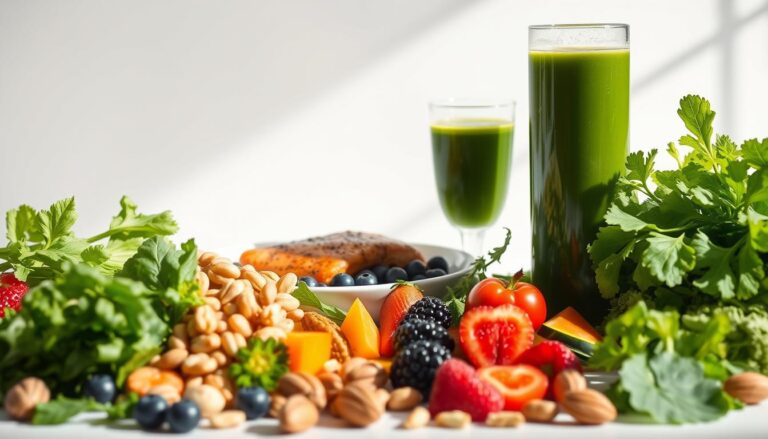Are you a cheese lover wondering if your love for it might be affecting your health goals? With so many types of cheese and sizes, figuring out how much to eat can be tough. But don’t worry, our expert guide will help you understand cheese’s role in a healthy diet.
Key Takeaways
- The recommended daily intake of dairy, including cheese, is 3 servings for adults and 2-2.5 servings for children.
- A serving of cheese is equivalent to 1.5-2 ounces, or about the size of a matchbox.
- Cheese can provide various health benefits, such as improved cardiovascular health, muscle mass, and bone strength.
- Consuming too much cheese can lead to high cholesterol, high blood pressure, and increased risk of cardiovascular disease.
- It’s important to consume cheese in moderation as part of a balanced diet.
The Pros and Cons of Daily Cheese Consumption
Benefits of Cheese: Cardiovascular Health and Muscle Mass
Cheese can be good for your health if eaten in small amounts. It has proteins, probiotics, and is made through fermentation. These can help keep your heart healthy by lowering blood pressure and stroke risk. Cheese also helps build and keep muscle mass.
In the U.S., people eat more cheese now than in 1970. A small piece of cheddar cheese gives you 20% of the daily calcium you need if you’re between 19 and 50 years old. Grass-fed cheese has more CLA than regular cheddar, which is good for your heart.
But, eating too much cheese can be bad for you. It has a lot of saturated fat and sodium, which can raise your cholesterol and blood pressure. Some worry that dairy products might have hormones that could increase cancer risk.
| Pros of Cheese Consumption | Cons of Cheese Consumption |
|---|---|
|
|

“Cheese can be a nutritious addition to a balanced diet, but it’s important to consume it in moderation due to its high saturated fat and sodium content.”
Dietary Guidelines: Recommended Cheese Servings
Exploring the world of cheese can be fun, but knowing how much to eat is key. The latest guidelines suggest adults should have 3 servings of dairy a day. Kids need 2 to 2.5 servings.
A cheese serving is about 1.5 to 2 ounces. Older people need more dairy than younger ones. It’s important to watch how much cheese you eat. Choose lower-fat options to stay healthy.
| Age Group | Recommended Dairy Servings per Day |
|---|---|
| Toddlers (1-2 years) | 1-1.5 servings |
| Children (2-8 years) | 2-2.5 servings |
| Adolescents and Teenagers (9-18 years) | 3-3.5 servings |
| Adults (19-50 years) | 3 servings |
| Older Adults (51+ years) | 3-4 servings |
These guidelines are for everyone, but your needs can change based on your life. Your activity level, diet, and health can affect how much cheese you should eat. By following these guidelines, you can enjoy cheese without harming your health.

“Moderation is key when it comes to cheese consumption. Stick to the recommended servings to reap the nutritional benefits without compromising your overall health.”
Nutritional Breakdown: What’s in Cheese?
Cheese is a powerhouse of nutrients, packed with vitamins, minerals, and macronutrients. From creamy cheddar to tangy feta, it’s a nutritional delight. This dairy treat offers a punch that’s hard to ignore.
Key Nutrients and Their Benefits
One ounce of hard cheese has about 120 calories, 8 grams of protein, 6 grams of saturated fat, and 180 milligrams of calcium. A half-cup of 4% full-fat cottage cheese has 120 calories, 14 grams of protein, 3 grams of saturated fat, and 80 milligrams of calcium.
Cheese is full of phosphorus, potassium, and probiotics. These nutrients are key for cardiovascular health, muscle mass, and gut well-being. But, cheese can be high in sodium, with most types having 300-450 milligrams per serving.
| Nutrient | Benefits |
|---|---|
| Calcium | Supports bone health and muscle function |
| Protein | Aids muscle growth and repair |
| Probiotics | Promotes a healthy gut microbiome |
| Vitamin A | Supports vision, skin, and immune function |
| Vitamin B12 | Maintains healthy blood and nerve function |
Cheese can be a great addition to a balanced diet, if eaten in moderation. It’s part of a healthy lifestyle.
How Much Cheese Should You Eat Daily?
Experts suggest a balanced approach to daily cheese intake. The right amount varies by age and dietary needs. Aim for one to three servings a day, with each serving about 1.5-2 ounces.
Cheese is good for protein and calcium, but too much isn’t. Too much can raise cholesterol, blood pressure, and heart disease risk. Choose lower-fat cheeses and watch your portions to stay healthy.
| Nutrient | Recommended Daily Intake | Cheese Serving (1.5-2 oz) |
|---|---|---|
| Protein | 0.8 g/kg of body weight | 5-7 g |
| Calcium | 1,000 mg (ages 19-50) | 100-125 mg (30% of RDA in Parmesan) |
| Sodium | Less than 2,300 mg | 180-240 mg |
| Saturated Fat | Less than 5-6% of calories | 5-7 g |
Enjoy cheese but keep it in check. Pick low-fat options and control your portions. This way, you can enjoy cheese’s benefits without the risks.

“Eating 1.4 ounces of cheese per day may be optimal for heart health benefits.”
Lactose Intolerance: Alternatives to Dairy
For those with lactose intolerance, enjoying dairy products like cheese can be tough. But, there are many plant-based alternatives that offer similar nutrition without the lactose. You can find everything from creamy plant-based milk to tasty plant-based cheese options.
Plant-Based Milk, Yogurt, and Cheese Options
Soy milk, almond milk, oat milk, and more are great for those who need a lactose-free option. These alternatives are not only lactose-free but also packed with nutrients like calcium and vitamin D. Plant-based yogurt and plant-based cheese give you a creamy taste without the lactose in regular dairy.
- Soy milk: It’s full of protein and calcium, making it a top choice for dairy alternatives.
- Almond milk: This milk is creamy and low in calories, perfect for those looking for a lactose-free drink.
- Oat milk: It’s naturally sweet and smooth, becoming a favorite among those avoiding dairy.
- Plant-based yogurt: Made from soy, almond, or coconut milk, it has a creamy texture like traditional yogurt.
- Plant-based cheese: There are many kinds, from shredded to spreadable, for cheese lovers without lactose issues.
These lactose intolerance-friendly options let people enjoy dairy’s flavors and textures without the stomach issues. With so many dairy alternatives out there, finding a balanced, lactose-free diet is easier than ever.

Strategies for Sensible Cheese Consumption
Enjoying cheese as part of a balanced diet means thinking carefully. Here are some tips to help you enjoy cheese without harming your health.
- Practice Portion Control: Use a scale or measuring cup to keep your cheese intake in check. Aim for a 30-gram serving, which has 0 to 9 grams of fat.
- Choose Healthier Cheese Options: Pick lower-fat cheeses like mozzarella, feta, or cottage cheese. They have fewer calories and less saturated fat.
- Limit How Often You Eat Cheese: Cheese can be tasty, but don’t eat it too often. Try to balance your meals and eat cheese only a few times a week.
- Use Cheese Mindfully: When cooking, use less cheese or try other ingredients for flavor. This can help cut down on fat and calories.
| Nutrient | Recommended Daily Intake | Cheese Contribution |
|---|---|---|
| Calories | Men: 2,500 | Women: 2,000 | A 30g portion of cheese can provide approximately 0 to 90 calories, depending on the type. |
| Saturated Fat | Men: ≤30g | Women: ≤20g | Cheese can be a significant source of saturated fat, with some varieties containing up to 9g per 30g serving. |
| Calcium | 1,000mg | Cheese is particularly rich in calcium, providing up to 30% of the recommended daily intake in a 30g portion. |
By following these tips, you can enjoy cheese’s great taste and health benefits. Remember, eating cheese in moderation is key to a healthy diet.

“Cheese is a way of life, and life is too short to not enjoy it in moderation.”
Debunking Cheese Myths: Addiction, Bone Health, and More
Cheese is a favorite dairy treat, often surrounded by myths. Claims about its addictive nature and effects on bone health need to be checked. Let’s look at what’s true and what’s not.
Myth 1: Cheese is Addictive
Cheese has casein, a protein that can release opiates during digestion. But, there’s no strong proof that this makes people addicted. The idea of “cheese addiction” is often exaggerated and not backed by science.
Myth 2: Cheese is Necessary for Bone Health
Cheese is rich in calcium, which is good for bones. But, it’s not the only way to keep bones strong. Foods like milk, yogurt, and leafy greens also help with bone health. In fact, places with the lowest dairy intake often have fewer bone fractures.
- A study found that women who ate the most dairy broke more bones than those who didn’t.
- Countries with the highest osteoporosis rates drink the most milk and have the most calcium in their diets.
Myth 3: Organic Cheese is Healthier
Organic food is often seen as healthier, but organic cheese isn’t always free of pesticides. It also doesn’t always have more nutrients than non-organic cheese. Knowing the facts about organic food can help people make better choices.
“Dairy products are the top source of saturated fat in the American diet, contributing to heart disease, diabetes, and Alzheimer’s disease.”
In conclusion, it’s important to be careful when choosing cheese. By knowing the truth about these myths, people can make better choices for their diets.
Cheese in Culinary Creations: Mindful Additions
Cheese can make many dishes taste better and feel richer. But, it’s key to use it wisely for a balanced meal. Think about how much and what kind of cheese you add to your recipes.
Using grated or shredded cheese is a simple way to add flavor without overdoing it. Choose lower-fat or reduced-fat cheese varieties to keep calories and fat down. Remember, too much cheese can add a lot of calories, fat, and sodium.
Cheese has been around since 8000 BC, and there are so many kinds out there. Hard cheeses like cheddar and parmesan are rich in fat and protein. Soft cheeses like ricotta and cottage cheese are lower in fat. Mindful cheese consumption lets you enjoy its benefits without getting too full or gaining weight.
| Cheese Variety | Protein (g) | Fat (g) | Calories |
|---|---|---|---|
| Cheddar | 7.1 | 9.3 | 113 |
| Parmesan | 10.3 | 4.6 | 97 |
| Ricotta | 4.8 | 4.5 | 60 |
| Cottage Cheese | 11.1 | 2.3 | 69 |
Being careful with how much you use and choosing the right cheese can make your meals both tasty and healthy. This way, you can enjoy cheese without worrying about your diet.
“Cheese is a profound, beautiful, and delicious reminder that life is a miraculous, effortless, and abundant gift.”
Conclusion
Cheese can be a tasty addition to a balanced diet if eaten in moderation. Adults should aim for one to three servings a day, based on their age and dietary needs. Cheese is packed with nutrients like calcium, protein, and probiotics. But, it also has saturated fat and sodium, which aren’t good for health if eaten too much.
To eat cheese healthily, pick lower-fat or reduced-fat types. Control how much you eat and think about how cheese fits into your meals. This way, you can enjoy the good stuff while avoiding the bad.
So, go ahead and enjoy a slice or two of cheese. But, eat it with care and watch your total intake. With some cheese knowledge, you can eat well and stay healthy.





